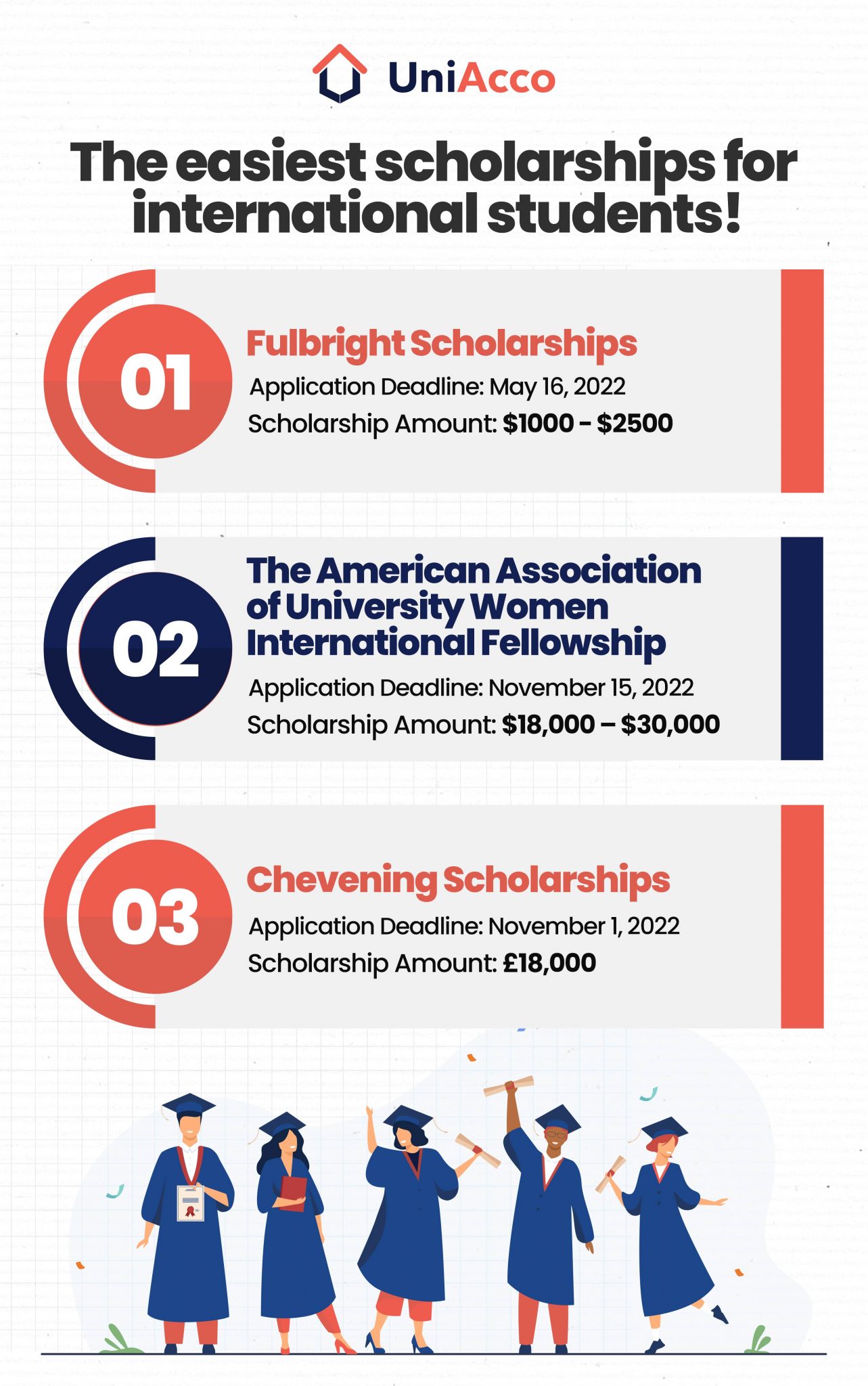Scholarships for International Students: Your Ultimate Guide to Funding Your Global Education
Are you dreaming of studying abroad, exploring new cultures, and gaining a world-class education? While the idea is exciting, the cost of international education can often feel like a huge barrier. Tuition fees, living expenses, travel, and health insurance can quickly add up, making many aspiring international students wonder if their dream is truly achievable.
The good news? It absolutely is! Scholarships for international students are your golden ticket to making that dream a reality. These incredible financial awards are designed specifically to help students from all over the world pursue their education in a foreign country without the crippling burden of debt.
This comprehensive guide will break down everything you need to know about finding, applying for, and winning scholarships. We’ll make it easy to understand, even if you’re completely new to the world of international financial aid. Let’s dive in!
Why Scholarships are Essential for International Students
For international students, scholarships are more than just financial aid; they are a lifeline. Here’s why they are so crucial:
- Reduce Financial Burden: The most obvious benefit. Scholarships can cover a significant portion, or even all, of your tuition fees, accommodation, living expenses, and even travel costs. This allows you to focus on your studies rather than worrying about money.
- Access Top Universities: Many top-tier universities worldwide have high tuition fees. Scholarships can make these elite institutions accessible to talented students regardless of their financial background.
- Enhance Your Resume: Being a scholarship recipient looks fantastic on your resume. It demonstrates academic excellence, perseverance, and often, leadership potential.
- Cultural Immersion: With financial worries lessened, you can fully immerse yourself in the new culture, participate in extracurricular activities, and make the most of your international experience.
- Networking Opportunities: Some scholarships come with mentorship programs, networking events, and access to a community of like-minded scholars, opening doors for future career opportunities.
Types of Scholarships Available for International Students
Scholarships come in many forms, each with its own criteria and purpose. Understanding the different types will help you narrow down your search.
1. Merit-Based Scholarships
These are awarded based on a student’s academic achievements, high test scores (like SAT, ACT, GRE, GMAT), exceptional talents (music, art, sports), or leadership qualities.
- Who it’s for: Students with strong grades, impressive resumes, or outstanding extracurricular accomplishments.
- Example: A scholarship for students with a GPA above 3.8, or a scholarship for a talented musician.
2. Need-Based Scholarships
These scholarships are awarded based on the student’s demonstrated financial need. You’ll typically need to provide detailed financial information about your family’s income and assets.
- Who it’s for: Students who can prove they genuinely need financial assistance to afford their studies abroad.
- Example: A university grant for students from low-income backgrounds.
3. Specific Country/Region Scholarships
Many governments and institutions offer scholarships specifically for students from certain countries or regions, or for students wishing to study in a particular country.
- Who it’s for: Students whose nationality or desired study destination matches the scholarship’s focus.
- Examples: Fulbright Program (USA), Chevening Scholarships (UK), DAAD Scholarships (Germany), Endeavour Scholarships (Australia).
4. Program-Specific Scholarships
These are tailored to students pursuing a particular field of study or major (e.g., STEM, arts, humanities, business, medicine).
- Who it’s for: Students who have chosen a specific academic path.
- Example: A scholarship for women pursuing engineering degrees, or a grant for research in environmental science.
5. Diversity Scholarships
These scholarships aim to promote diversity by supporting students from underrepresented groups, minority backgrounds, or specific demographic profiles.
- Who it’s for: Students who meet specific demographic criteria set by the scholarship provider.
- Example: Scholarships for students from developing countries, or for indigenous students.
6. Sports Scholarships
If you’re an outstanding athlete, many universities, especially in the USA, offer scholarships based on your sporting talent. You’ll need to meet academic requirements as well.
- Who it’s for: Student-athletes who excel in a particular sport and can contribute to a university’s team.
Where to Find Scholarships for International Students
Finding the right scholarship can feel like searching for a needle in a haystack, but knowing where to look makes it much easier.
1. University Websites
This is often the best place to start. Most universities have dedicated "Financial Aid" or "Scholarships" sections on their websites.
- Tip: Look for scholarships specifically for international students, as many institutional scholarships are only for domestic students. Check both general university scholarships and departmental scholarships.
2. Government Programs
As mentioned earlier, many governments offer significant scholarships to attract international talent.
- Examples:
- USA: Fulbright Foreign Student Program
- UK: Chevening Scholarships, Commonwealth Scholarships
- Germany: DAAD (German Academic Exchange Service)
- Canada: Vanier Canada Graduate Scholarships
- Australia: Australia Awards Scholarships
- Tip: Visit the official websites of the education departments of your target study countries.
3. Scholarship Search Engines & Databases
These platforms compile thousands of scholarships from various sources.
- Popular options:
- ScholarshipOwl: Matches you with scholarships based on your profile.
- Fastweb: Large database, personalized matches.
- BigFuture (College Board): Comprehensive database, primarily for US schools but includes international options.
- IEFA.org (International Education Financial Aid): Specifically for international students.
- Studyportals Scholarship Database: Good for searching by country and field.
- Scholars4Dev: Focuses on scholarships for developing countries.
- Tip: Create detailed profiles on these sites to get more accurate matches.
4. Non-Profit Organizations & Foundations
Many private organizations, charities, and foundations offer scholarships based on their mission or specific criteria.
- Examples: Rotary International, Soroptimist International, Aga Khan Foundation.
- Tip: Research organizations related to your field of study, your home country, or your personal background.
5. Your Home Country’s Government or Institutions
Sometimes, your own government or private organizations in your home country offer scholarships for citizens to study abroad.
- Tip: Check with your Ministry of Education or relevant cultural exchange offices.
Eligibility Criteria: Do You Qualify?
Before you get excited about a scholarship, always check the eligibility criteria. These can vary widely but commonly include:
- Academic Performance: Minimum GPA, specific test scores (e.g., IELTS/TOEFL for English proficiency, SAT/ACT for undergraduate, GRE/GMAT for graduate).
- Nationality/Citizenship: Many scholarships are restricted to citizens of specific countries.
- Financial Need: For need-based scholarships, you’ll need to demonstrate your financial situation.
- Field of Study: Some scholarships are only for specific majors or programs.
- Level of Study: Undergraduate, graduate (Master’s, PhD), or postdoctoral.
- Age Limit: Less common, but some scholarships have age restrictions.
- Leadership & Extracurriculars: Demonstrated involvement in community service, clubs, sports, or leadership roles.
Important: Never apply for a scholarship you don’t qualify for. It’s a waste of your time and the scholarship provider’s.
Mastering the Scholarship Application Process
Once you’ve found suitable scholarships, the application process is where you truly shine. Treat it like applying for a job – professional, meticulous, and tailored.
1. Start Early, Really Early!
Scholarship deadlines are often a year or more before the academic year starts. Give yourself plenty of time to research, gather documents, and perfect your application.
- Tip: Create a timeline for each scholarship with key dates.
2. Read All Instructions Carefully
This cannot be stressed enough. Scholarship providers are looking for attention to detail. Missing a single requirement can lead to immediate disqualification.
- Tip: Print out the instructions and check off each item as you complete it.
3. Tailor Your Application to Each Scholarship
Do not use a generic application for every scholarship. Each essay, each answer, should directly address the scholarship provider’s mission, values, and criteria.
- Think: Why this scholarship for you? How do your goals align with their goals?
4. Craft a Compelling Essay/Personal Statement
This is your chance to tell your story and stand out.
- Be Authentic: Share your unique experiences, passions, and aspirations.
- Show, Don’t Just Tell: Instead of saying "I am a leader," describe a situation where you demonstrated leadership.
- Address the Prompt: Directly answer the essay question.
- Connect to the Scholarship: Explain why you deserve this specific scholarship and how it will help you achieve your goals.
- Proofread: Typos and grammatical errors are instant red flags. Get multiple people to read it.
5. Gather Strong Letters of Recommendation
Choose recommenders (teachers, professors, employers) who know you well and can speak positively about your abilities, character, and potential.
- Give Ample Time: Ask for letters well in advance of the deadline.
- Provide Information: Give your recommenders all necessary information: the scholarship’s purpose, your resume, your personal statement, and the deadline.
6. Prepare All Required Documents
This typically includes:
- Official transcripts from all previous educational institutions.
- Proof of English proficiency (IELTS, TOEFL) or other language tests.
- Standardized test scores (SAT, ACT, GRE, GMAT).
- Resume/CV.
- Financial statements (for need-based scholarships).
- Copy of your passport.
7. Showcase Your Extracurricular Activities and Leadership
Scholarship committees look for well-rounded individuals. Highlight any volunteer work, club memberships, sports, part-time jobs, or leadership roles you’ve held. Quantify your achievements where possible (e.g., "Led a team of 5 volunteers").
8. Proofread, Proofread, Proofread!
Seriously, proofread everything one last time before submitting. Then ask someone else to proofread it too. A fresh pair of eyes can catch mistakes you missed.
Common Mistakes to Avoid
- Missing Deadlines: The #1 reason for rejection.
- Not Following Instructions: Leads to automatic disqualification.
- Generic Applications: Submitting the same essay for multiple scholarships.
- Ignoring Small Scholarships: Many students only apply for full-ride scholarships. Smaller awards (e.g., $500 or $1,000) add up and are less competitive.
- Giving Up Too Soon: The scholarship search is a marathon, not a sprint. Persistence is key.
- Not Asking for Help: Reach out to your school counselors, professors, or university financial aid offices.
Beyond Scholarships: Other Funding Options
While scholarships are fantastic, it’s wise to consider other funding sources to create a robust financial plan for your international studies.
- Part-Time Jobs: Many countries allow international students to work part-time during their studies (e.g., 20 hours/week during term, full-time during breaks). Check the visa regulations of your target country.
- Student Loans: While not ideal, government or private student loans can be an option, but proceed with caution. Understand interest rates and repayment terms. Some countries offer loans specifically for international students.
- Family Contributions: Discuss with your family what financial support they might be able to offer.
- Crowdfunding: Platforms like GoFundMe or others dedicated to education can help you raise funds from your community.
- University Assistantships/Fellowships (for Graduate Students): Many graduate programs offer teaching assistantships (TA), research assistantships (RA), or fellowships that include a stipend and often a tuition waiver in exchange for work.
Conclusion
Studying abroad is an incredibly enriching experience that can transform your life and career. While the financial aspect can seem daunting, scholarships for international students are designed to make these dreams attainable.
The journey to securing a scholarship requires dedication, thorough research, and a meticulously crafted application. Start early, be persistent, tailor every application, and never underestimate the power of a compelling personal story.
Don’t let financial concerns hold you back from your global education. With the right strategy and effort, you can find the funding you need to embark on your exciting international academic adventure. Start exploring today – your future self will thank you!



